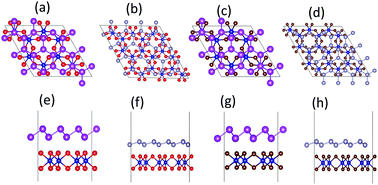Magnetism and electronic structures of bismuth (stannum) films at the CrI3 (CrBr3) interface†
Abstract
From first-principles calculations, the magnetism and electronic structures of bilayer bismuth (stannum) films at the monolayer CrI3 (CrBr3) interface are studied. The Curie temperature (TC) of CrX3 (X = Br, I) can be enhanced by coupling bilayer bismuth (Bi) with van der Waals (vdW) heterostructures. The n-doping of CrX3, induced by interlayer charge-transfer from the Bi film, leads to the enhancement of TC. The quantum spin Hall phases of bilayer bismuth and stannum films are destroyed by the magnetic substrate. Although the interface system of the bilayer stannum (Sn) film on a CrBr3 monolayer shows a band gap (57 meV), the inexistence of edge states with valence and conduction bands connected across the insulating gap is a manifestation of the trivial state without the feature of quantized anomalous Hall effect in the interface. The percentage reduction of the corresponding work function is 22.6%, 12.7%, 25.4% and 16.5% for Bi/CrI3, Sn/CrI3, Bi/CrBr3 and Sn/CrBr3 interface systems, respectively. Our findings demonstrate that the Bi(Sn)–CrI3(CrBr3) interface system with vdW engineering is an efficient way to tune magnetism and electronic structures, which is of importance for future applications in spintronics and nanoelectronics devices.



 Please wait while we load your content...
Please wait while we load your content...